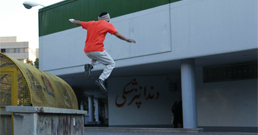Parkour is a non competitive, physical discipline of French origin in which participants run along a route, attempting to negotiate various obstacles in the most efficient way, using nothing but their bodies. Employing skills such as jumping, climbing, rolling and swinging, they have to take the most direct path through or over each obstacle as rapidly and safely as possible. The two primary characteristics of Parkour are efficiency and speed, for which a high degree of concentration and awareness of the surroundings as well as the ability to avoid injuries are essential. Parkour also influences the thought process by enhancing self-confidence and critical-thinking skills that allow everyday physical and mental obstacles to be overcome.
Parkour has its origins in the classic obstacle course – a method of military training – which was further expanded during World War I and II, and became the standard system of French military education and training. This in turn led to the development of civilian fitness and confidence building courses. Today’s Parkour was founded by David Belle, whose father, Raymond, was born in French Indochina and was brought up and trained by the military after he lost his parents in the Indochina war and the subsequent division of Vietnam. After repatriation and settling in France, Raymond introduced his own son, David, to obstacle course training and other activities such as martial arts and gymnastics. David continued to develop his strength and improve his skills, and later he formed a group called Yamakasi together with his brothers and a number of friends. A film under the same name in 2001 inspired many young people to take up Parkour.
Over the years, the number of dedicated practitioners grew, and from the Parisian suburbs, Parkour went on to become a widely practiced activity outside of France. The main reason for this rapid expansion and popularity is that Parkour is not just a set of physical activities, but behind it lies a philosophy and theory that are integral aspects of the art. It is about overcoming and adapting to mental and emotional obstacles as well as physical barriers. Each obstacle presents a unique challenge, and Parkour trains both body and mind to react to those obstacles appropriately with a technique that is practical and effective. It encourages the ability to overcome one’s fears and pains and apply this self-discipline to the deeper problems of life, as you must be able to control your own mind and body in order to master the art of Parkour.
It is this feeling of being in control and having a type of freedom which is perhaps one of the main attractions of Parkour for the young people around the world, including Iran. It did not exist in Iran until recent years when a few who had learned its techniques abroad returned and began to organize training sessions and joint activities in Tehran. From there its popularity has spread to most major cities, and the sight of young men practising their extraordinary skills in the streets, in parks, and on building sites is no longer unusual. It is a way in which today’s youth expend their energies and release their frustrations, whilst providing many with a motivation and discipline that calls upon high levels of dedication, mental concentration and physical fitness.
In this multimedia report, we visit a neighborhood in Tehran where a group of young Parkour enthusiasts demonstrate their spectacular skills and explain their incentives for taking up this unusual activity.


